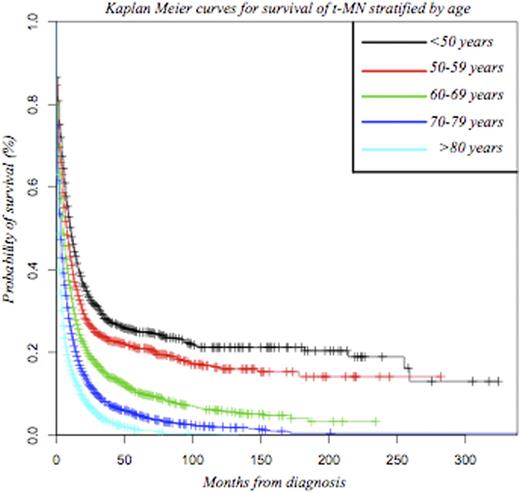Abstract
Introduction: World Health Organization (WHO) classifies therapy-related myeloid neoplasms (t-MN) into therapy related acute myeloid leukemia (t-AML), therapy related myelodysplastic syndrome (t-MDS), and therapy related myelodysplastic syndrome/myeloproliferative neoplasms (t-MDS/MPN). These diseases are aggressive hematological malignancies and only allogeneic transplant offers the possibility of long-term remission. We performed retrospective analyses of Surveillance, Epidemiology, and End-Results (SEER) database to examine differences in incidence and survival outcomes of t-MN across different races and ethnicities in United States (US).
Methods: Patients who developed t-MN following previous hematological or solid organ malignancies were included in the analyses. SEER registries classify race, ethnicity using 2000 US Census categories based on self- identification, medical records, death certificates and though linkage to Indian Health Service records. The race/ethnicity was categorized as non-Hispanic white (nHW), Hispanic white (HW), non-Hispanic Black (nHB), non-Hispanic Asian/Pacific islander (nHA/P), non- Hispanic American Indian/ Alaskan natives (nHI/A) and unknown groups (U). The patients were divided into various age group categories: <50 years, 50-59 years, 60-69 years, 70-79 years and >80 years. The statistical analyses were performed using SAS 9.4 software.
Results: 13990 patients were reported to SEER database during 2000-2012 period with the diagnosis of t-MN. The total number of newly diagnosed t-MN in various racial groups was: nHW-11307, HW-900, nHB-1018, nHA/P-708, nHI/A -51 and U-6. There was higher reporting of non-Hodgkin lymphoma in females and lung/bronchial malignancies in males across all racial groups. Comparing different age groups, 50 months OS rates were: 2%, 6%, 13%,22% and 26% for groups >80 years, 70-79 years, 60-69 years, 50-59 years and <50 years, respectively. (figure 1). Males had worse OS when compared with females, however it was not significant after adjusting for age. The annual incidence of t-MN was highest amongst nHWs at 5.4 (5.3-5.4) per 100,000 and was lowest in American-Indian at 3.5 (3.0-4.0) per 100,000. The mean OS from the diagnosis of t-MN in nHW, HW, nHB, nHA/P and nHA/I was 11.1 mo, 12.35 mo, 11.86 mo, 12.1 mo and 11.41 mo respectively. When compared with HWs, nHWs had worse OS (p=<0.001). Similarly, when compared between HWs and nHBs, the mean OS was 12.35 months in HW population versus nHB population (OS=11.86 months) (p=<0.001). Overall, it was observed that HWs had better OS and presented with t-MN at younger age.
Conclusion: In summary, the analyses of SEER database for t-MN revealed that t-MN developed in small proportion of patients exposed to cytotoxic agents or radiotherapy. nHWs non-had the highest incidence of reported t-MN, probably due to better access to healthcare and resources. There was statistically significant difference in the observed OS of HWs versus other ethnic groups. It appeared that the median age of diagnosis of t-MN in HW was 65 yrs, which made this racial group more likely to get definitive management for t-MN(allogeneic transplant). This might have contributed towards better overall survival in HW population. nHB group had statistically significant poor OS when compared with nHW or HW groups. The possible explanation could be, lack of access to healthcare, unable to get allogeneic transplant due to lack of donor availability or genetic variations such as polymorphisms in DNA repair enzymes and nucleotide excision repair pathways. The cancer survivors are living longer with novel treatment and are more likely to develop subsequent malignancies and population based studies are essential for identifying cohorts of at risk patients.
No relevant conflicts of interest to declare.
Author notes
Asterisk with author names denotes non-ASH members.


This feature is available to Subscribers Only
Sign In or Create an Account Close Modal